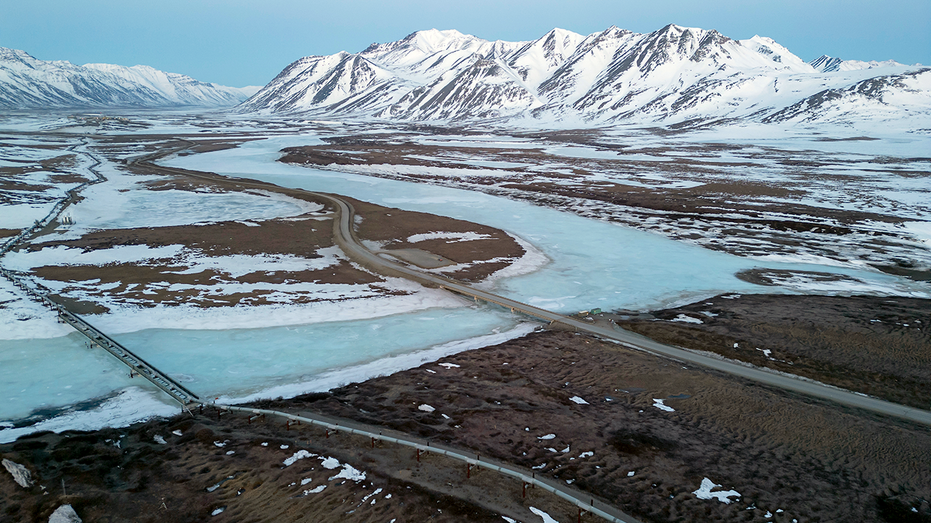
FIRST ON FOX: An expansive liquefied natural gas (LNG) project in the Arctic took a big step forward this week while officials at the Energy and Interior Departments heralded it as key to President Donald Trump’s "American energy dominance" agenda.
Alaska LNG, a branch of the New York City and Anchorage-based Glenfarne energy company, and energy technology giant BakerHughes announced an alliance that will bring to reality and accelerate plans for a nearly 1,000-mile, 42-inch LNG pipeline down the middle of the Last Frontier, and a corresponding terminal on the Kenai peninsula.
The 807-mile pipeline is projected to begin near Prudhoe Bay on the Arctic Ocean and run down to Nikiski – a village halfway between Anchorage and Homer.
Secretary of Energy Chris Wright and Secretary of the Interior Doug Burgum announced the agreement, with Glenfarne CEO Brendan Duval saying that BakerHughes’ partnership on the project is a big deal due to the company’s expertise in LNG compression technology.
LIZ PEEK: TRUMP WHITE HOUSE FIRED UP ABOUT KING COAL’S RETURN TO POWER
Duval said the deal reflects an increased momentum toward the mega-project’s future realization and praised the project’s ability to attract "global partners [in order] to achieve national and state energy objectives."
"Alaska LNG has the potential to be one of the most significant energy infrastructure projects in our nation’s history," Wright said in a statement to Fox News Digital.
"Today’s investment announcement is an important step forward for the project, prosperity in Alaska, and the energy security of America and our allies. The Trump administration remains committed to unleashing Alaska’s energy potential, including by supporting Alaska LNG."
CHALLENGER PRIMED TO FACE GOP'S LONGTIME SENATE DISSENTER AS TRUMP BRINGS NEW FOCUS TO ALASKA
Interior Secretary Doug Burgum added that U.S. LNG is "not just an energy source [but] a strategic asset that powers our economy."
Burgum, who chairs the National Energy Dominance Council, added that Glenfarne and BakerHughes working together will undoubtedly bear fruit in terms of new energy infrastructure that will create long-term affordable power for Americans that is based in America.
BakerHughes chairman Lorenzo Simonelli said in a statement that natural gas provides secure and reliable energy at an affordable rate to consumers. Simonelli also touted its lower carbon output than other fuels.
BURGUM, ZELDIN, WRIGHT: THIS IS HOW AMERICA WILL ACHIEVE ENERGY DOMINANCE
According to reports, the project will include a carbon-capture plant on Alaska’s remote North Slope that will have the capacity to remove seven million tons of carbon dioxide from the project annually.
Alaska’s energy potential has been repeatedly touted by Gov. Mike Dunleavy, who previously told Fox News Digital he is interested in an all-of-the-above approach devoid of politics that instead focuses on what will work and what will keep energy jobs in Alaska and the U.S. writ large versus overseas.
Dunleavy and Alaska officials battled the Biden administration over what they called intentional roadblocks against natural resources exploration in places like Ambler and the Arctic National Wildlife Refuge’s Section 1002; commonly dubbed ANWR.
RUSSIA PROPOSES 'PUTIN-TRUMP TUNNEL' WITH ELON MUSK'S HELP TO CONNECT NATIONS UNDER BERING STRAIT
Outside the Last Frontier’s ubiquitous natural gas and oil prowess, Dunleavy previously told Fox News Digital he would also be open to exploring the power-generating potential of tides in Cook Inlet – said to be the second-strongest lunar-powered ebb and flow in the world.
"That basin in Cook Inlet is the most energy-rich basin on the planet: onshore wind, offshore wind, coalfields, oil, gas, tidal, geothermal — all right there," he said, noting a separate wind farm on Anchorage’s Fire Island is easily visible from planes taking off at Ted Stevens International Airport.
He said, however, the major issue surrounding any green project is energy-storage capability, pointing to Germany as an example of where that problem has come up.
"You have to have something; a baseline power, which should be gas."
"What people need to know is that Alaska's got this enormous renewable potential that we're going to capitalize on – but you also have to be able to pay for the capital projects in renewables, such as hydro, solar, wind, and the storage — whether that's going to be pumped-hydro up here or some other way to store the energy — but you need to have oil and gas to help pay for that," Dunleavy said.


